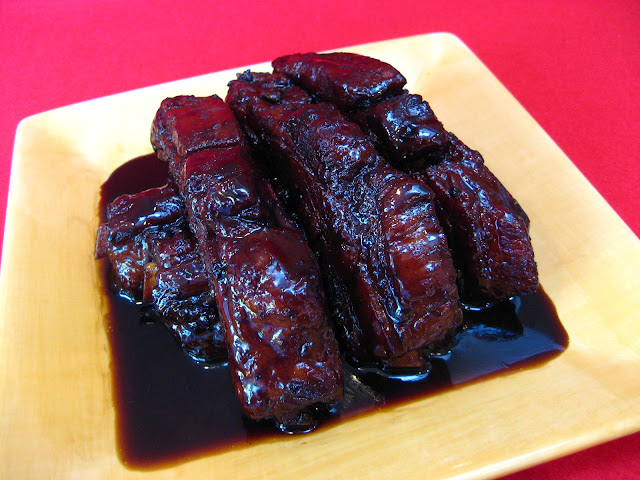This recipe was updated on 06 Aug 2015. Some instructions
and ingredient quantities were changed, and metric measurements added.
I was in the mood for noodles and had some salmon in my
refrigerator. I thought about the Cloud
Ear Salmon (雲耳鮭魚, Wan4 Ji5
Gwai1 Jyu4) recipe and decided that with some
modifications, the ingredients would make a great chow mein dish. The major
recipe changes are the use of green onions instead of fuzzy melon, and for the
sauce, substituting oyster sauce for soy.
Enjoy!
Ingredients
|
1 lb.
|
500 g.
|
Salmon (鮭魚, gwai1
jyu4), cut into 2-inch (5 cm.) pieces
|
|
½ in.
|
15 mm.
|
Knob of ginger
(薑, goeng1), crushed in a garlic
press
|
|
1 Tbs.
|
15 ml.
|
Corn starch (粟粉, suk1 fan2)
|
|
1 Tbs.
|
15 ml.
|
Shaoxing rice
wine (紹興酒, siu6 hing1 zau2)
or dry sherry
|
|
½ tsp.
|
2.5 ml.
|
Ground white pepper
(白胡椒, baak6 wu4 ziu1)
|
|
1 tsp.
|
5 ml.
|
Sesame oil (麻油, maa4 jau4)
|
|
|
|
|
|
10
|
10
|
Whole dried black
or cloud ear fungus (雲耳, wan4
ji5), rehydrated with stems removed
|
|
3 stalks
|
3 stalks
|
Green onions (葱, cung1), cut into 1-inch (2.5 cm.) pieces on the diagonal
|
|
½ in.
|
15 mm.
|
Knob of ginger
(薑, goeng1), crushed in a garlic
press
|
|
2 cloves
|
2 cloves
|
Garlic (蒜, syun3), crushed in a garlic press
|
|
1 lb.
|
500 g.
|
One package chow
mein noodles (炒麵, caau2 min6)
|
|
|
|
Oil for cooking
|
Sauce Ingredients
|
2 Tbs.
|
30 ml.
|
Lee Kum Kee brand premium oyster sauce (蠔油, hou4 jau4) or
equivalent
|
|
2 Tbs.
|
30 ml.
|
Soy sauce (豉油, si6
jau4)
|
|
1 Tbs.
|
15 ml.
|
Hoisin sauce (海鮮醬, hoi2
sin1 zoeng3)
|
|
2 Tbs.
|
30 ml.
|
Shaoxing rice wine (紹興酒,
siu6 hing1 zau2) or dry sherry
|
|
½ tsp.
|
2.5 ml.
|
Ground white pepper (白胡椒,
baak6 wu4 ziu1)
|
|
½ Tbs.
|
7.5 ml.
|
Sesame oil (麻油, maa4
jau4)
|
Equipment
|
|
|
Garlic press
|
|
14 in.
|
35.5 cm.
|
Wok or pan
|
 |
| Lee Kum Kee Brand Premium Oyster Sauce (蠔油, hou4 jau4) |
Preparation Instructions
- Take the salmon out of the refrigerator at least one hour before cooking. Prepare the salmon by removing any bones, and cut the meat into 2-inch (5 cm.) pieces. Marinate for at least one hour with the ginger crushed in a garlic press, corn starch, Shaoxing rice wine or dry sherry, ground white pepper, and sesame oil.
- Pour boiling water over the dried black or cloud ear fungus in a heat proof bowl and rehydrate the fungus for at least one hour. Remove the fungus from the rehydration liquid, discard the rehydration liquid, remove the stems from the fungus, and cut them into 2-inch (5 cm.) pieces if desired.
- Crush the ginger and garlic in a garlic press and put into a small bowl.
- Wash and cut the green onions into 1-inch (2.5 cm.) pieces on the diagonal.
- Prepare and mix the sauce in a small bowl: add the Lee Kum Kee brand premium oyster sauce or equivalent, soy sauce, hoisin sauce, Shaoxing rice wine or dry sherry, ground white pepper, and sesame oil.
Cooking Instructions
- Cook the noodles according to the instructions on the package and until the noodles are al dente. Drain the noodles and set aside. If using thawed, ready-made, or fresh noodles, “fluff” the noodles to separate them (i.e. you don’t want put a single mass of noodles into the wok).
- Heat a wok or pan over high heat before adding oil and then the salmon. Stir fry the salmon until brown by placing the salmon skin side down in the wok and leaving the salmon alone for a while before flipping it over to brown the other side. You may have to stir fry the salmon in batches, so be sure to reheat the wok over high heat before adding more oil. Transfer the browned salmon to a bowl.
- Reheat the wok over high heat before adding oil and then the black or cloud ear fungus. Stir fry the fungus to brown them. Add the bowl with the ginger and garlic mixture, and then some oil to the mixture. Quickly stir fry all the ingredients until the ginger and garlic mixture becomes fragrant. Transfer the contents of the wok to the bowl with the salmon.
- Reheat the wok over high heat before adding more oil and then the noodles. The wok should be very hot before adding the oil and then the noodles. Noodles cooked in a restaurant wok (over much higher heat than that available in your kitchen) are served slightly burned, which gives the noodles an extra added flavor. To try to emulate slightly burned noodles, try to put the noodles in one layer in the hot wok and add some liquid (water, stock, or Shaoxing wine; but not too much liquid otherwise you’ll steam the noodles) to facilitate the heat transfer from the wok to the noodles, and leave the noodles alone. You want the noodles to get burned before adding more oil to the noodles and turning them over, repeating the process.
- Add the green onions and the contents of the bowl with the salmon back into the wok, and stir fry all the ingredients together. Add the sauce ingredients to the wok and mix the ingredients together. Put the cooked ingredients into a serving dish and serve immediately.






